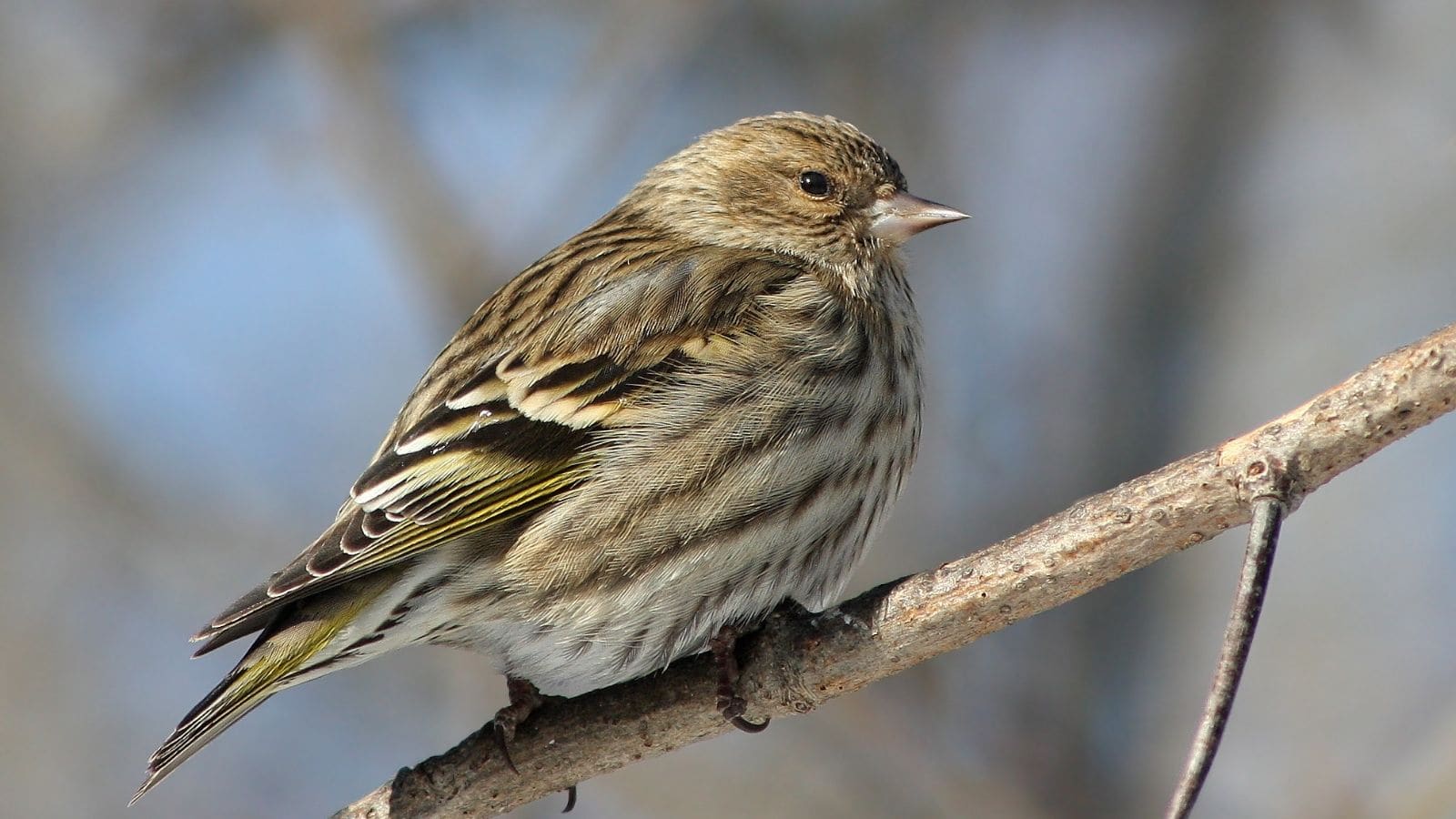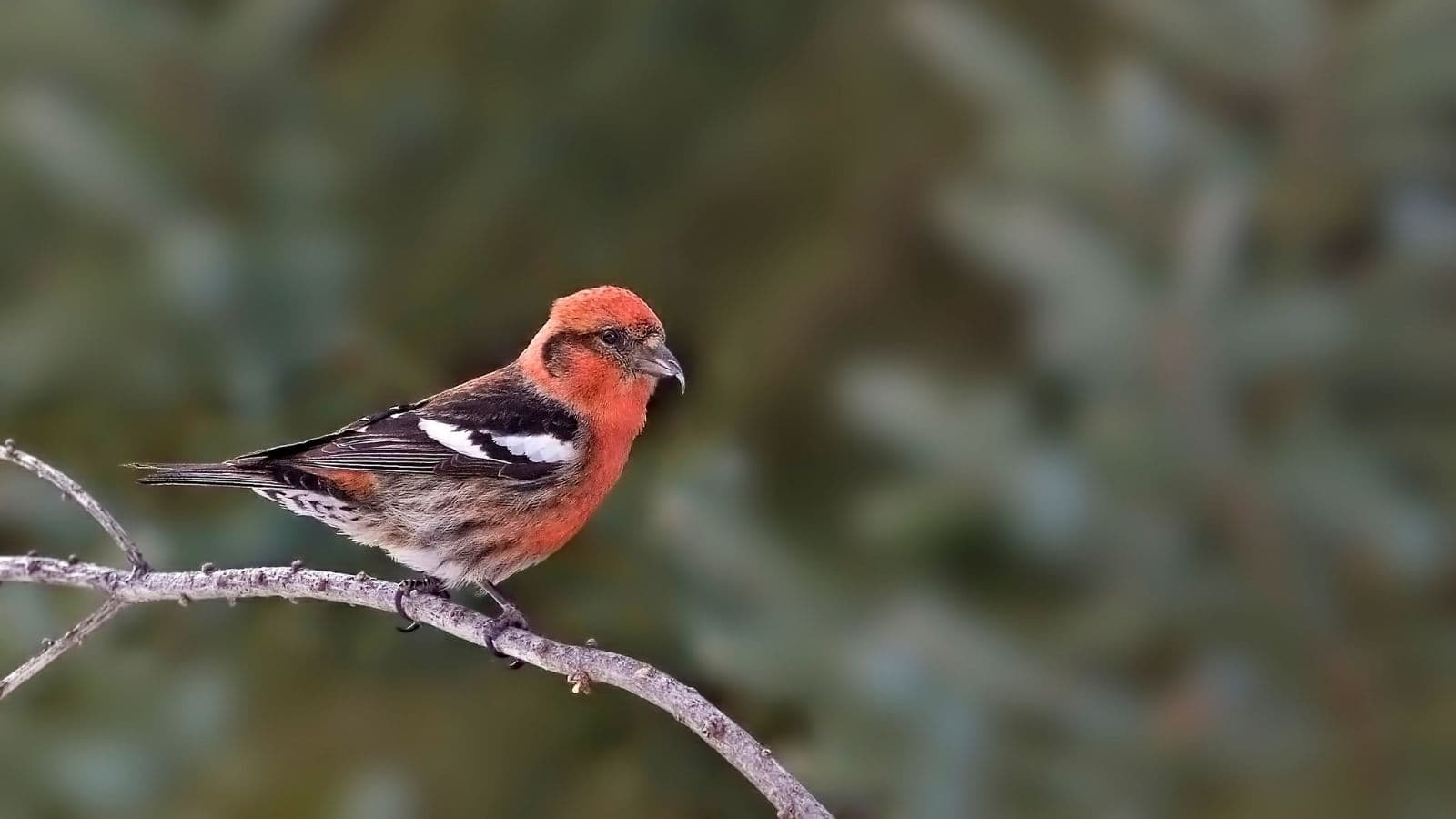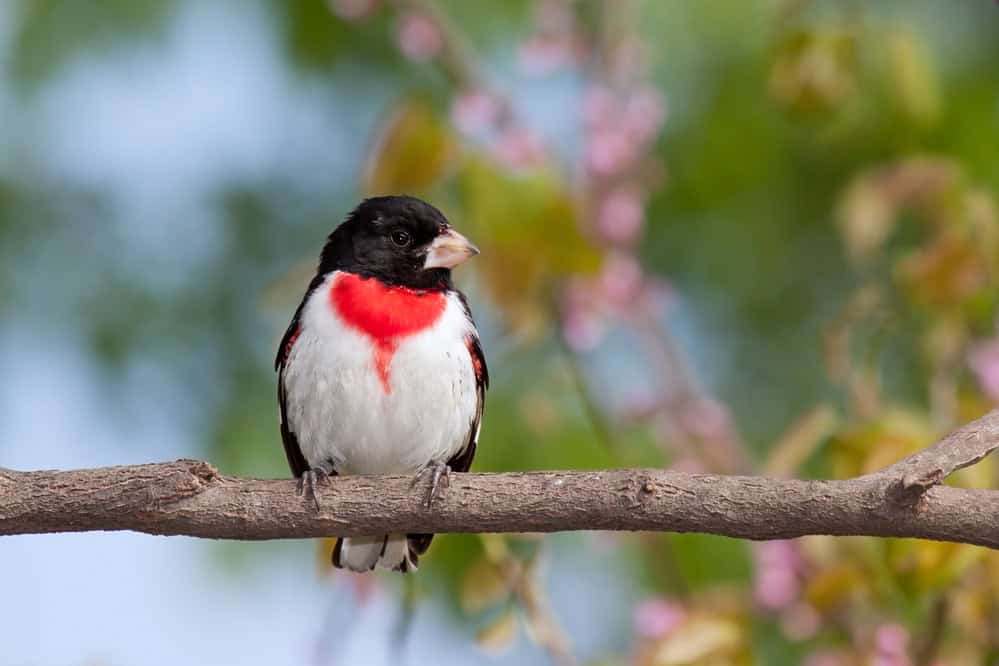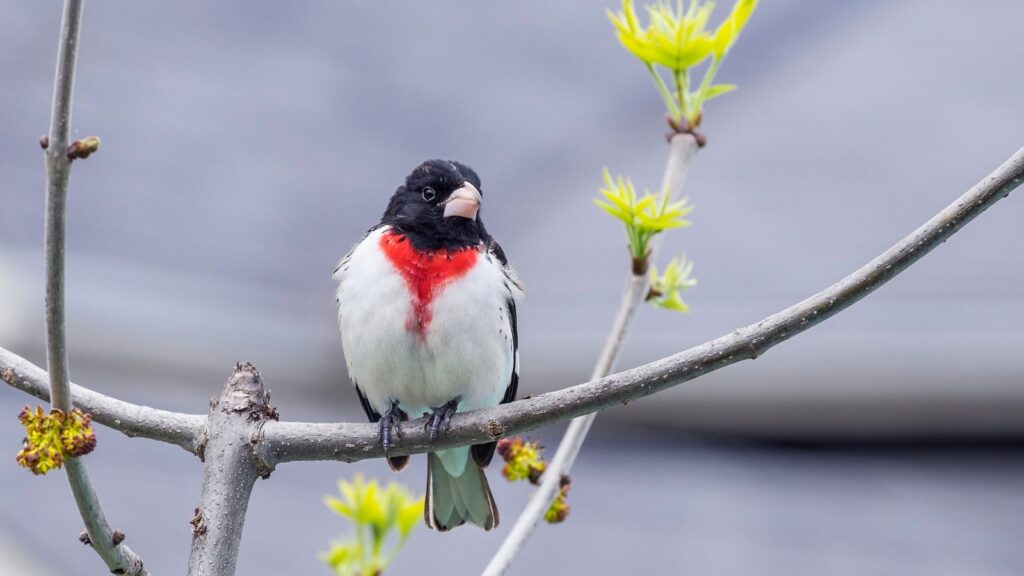Minnesota is a bird lover’s paradise. With over 10,000 lakes (seriously!) and plenty of forests, this lush environment lets you see 10 different finch species.
Finches are quaint little songbirds with conical bills – this unique beak shape allows them to eat a variety of different foods. As such, they make their home all throughout the United States.
Minnesota is a particularly appealing state for finches thanks to a bounty of coniferous and deciduous forests. Several of the finch species below have a close relationship with these woodlands and it even reflects in their beak shape.
Curious to learn more about these delightful birds and how to spot them? My guide has birding tips on their appearance, behaviors, and more.
Pine Siskin

- Species Name: Spinus pinus
- Length: 11 cm to 14 cm
- Weight: 12 grams to 18 grams
- Wingspan: 18 cm to 22 cm
Minnesota is home to several coniferous forests, the preferred stomping grounds of the pine siskin. Their very name is an homage to their main diet.
Appearance
A glance at the pine siskin may have you thinking you’ve encountered a completely different bird species. These finches are among the smallest of the finch family and have a surprisingly tiny beak!
Male pine siskins have a light yellow-brown body covered in streaks. Their wings have a brighter yellow that flashes every time they open their wings.
The females look extremely similar to the males but with less yellow on their wings.
Range
This finch’s range is a little varied depending on the season. They crop up more abundantly during the winter months but linger year-round in the northeast part of the state.
These are the kinds of finches you seek out when you go on a hiking excursion through the forest. They don’t usually visit urban areas and prefer to stick to their favorite pine trees.
Diet
Three guesses what the pine siskin prefers to eat! This adorable bird is usually hard at work digging out conifer seeds, but they sometimes eat flower buds or weed seeds.
You’re most likely to attract a pine siskin during winter with thistle or millet.
Birdsong
This bird has an excitable, sharp call you’ll notice instantly. It’ll sound much like a squealing tzweee or tzeee.
Fun Fact
The pine siskin can be a little unpredictable thanks to their nomadic flight patterns. While they prefer to stick to forests, they can still show up in completely different environments out of the blue!
Purple Finch

- Species Name: Haemorhous purpureus
- Length: 12 cm to 16 cm
- Weight: 18 grams to 32 grams
- Wingspan: 22 cm to 26 cm
Purple finches may not actually be purple, but they are certainly charming. Their bold coloration is regularly the subject of bird photography and traditional paintings.
Appearance
The male purple finch stands out instantly for its blushy coloration. His pinkish-red plumage stands out stark against his pale belly and gray-brown wings.
The female purple finch may not have any red, but I think she’s darling in her own right. She has a light brown body with white and brown streaks.
If you look closely, you can see her quirky white eyebrow and spotted stomach.
Range
These finches are one of the easiest to spot in Minnesota thanks to their wide range. You’ll see plenty during the breeding season in the northeast, then all over the state during winter.
Purple finches are fond of forested areas where they can forage and build their nests. However, they’ll happily visit a well-stocked feeder when it gets cold.
If you’re looking to spot these birds in their natural environment, consider visiting the Minnesota Valley National Wildlife Refuge. This gorgeous location has biking zones, hiking trails, and fishing opportunities, too!
Diet
Purple finches like to shake up their diet according to the season. They dig around for insects during the summer but switch to berries and fatty seeds during winter.
If you want to enjoy some peaceful backyard birding, fill up your feeder with sunflower seeds or millet. You’ll increase your chances of seeing them if you put your feeder next to tree cover or near some shrubs.
Birdsong
The purple finch song is a pure classic. Expect to hear long, lilting warbles and twitters with repeating notes.
Fun Fact
Purple finches are sociable birds and will sometimes feed in flocks of up to 30 birds!
House Finch

- Species Name: Haemorhous mexicanus
- Length: 13 cm to 14 cm
- Weight: 16 grams to 27 grams
- Wingspan: 20 cm to 25 cm
Beginning birders sometimes confuse the house finch with the purple finch. They do look quite similar, so let’s take a look at the difference below.
Appearance
The male house finch shares the purple finch’s blushing coloration. However, only his head and throat are red – the rest of his body is a grayish brown.
The female house finch has a light gray-brown body with flecks of white on her stomach. Her large, pale conical bill is easy to spot at a distance.
Range
The house finch’s name is your first clue to how common it is – as common as a house! These finches are year-round residents of Minnesota and crop up in urban and forested environments.
You’re just as likely to see house finches near forest edges as you are to see them in parks.
Diet
House finches enjoy a rich diet such as buds, seeds, fruits, and berries. They’re especially fond of orchards and will actively seek out cherries, nectarines, or plums.
You don’t need an orchard to attract a house finch, though – just stock up on sunflower seeds and millet. These gregarious birds will often bring their friends and are known to shoo other species away from feeders.
Birdsong
The house finch song is lively and high-pitched, often composed of chirps and warbles.
Fun Fact
This finch is so unafraid of people that they’ll often build their nests on top of or near buildings.
Evening Grosbeak

- Species Name: Hesperiphona vespertina
- Length: 16 cm to 22 cm
- Weight: 38 grams to 68 grams
- Wingspan: 30 cm to 36 cm
This finch’s coloration is among the most striking of the finch family. In fact, they look more like parrots than a songbird!
Appearance
The male evening grosbeak is a larger bird with a bold yellow body, black wings, and white patches. His thick yellow eyebrow gives him a rather fierce expression.
The female evening grosbeak cuts a striking figure with her light gray body, dark wings, and yellow neck. If you have binoculars, you may see the gentle white flecks on her wing bars and tail.
Range
These stocky finches usually show up year-round in the northeastern part of the state. However, they prefer the southern and western portions only during the non-breeding season.
While lakes are among Minnesota’s best-known natural landmarks, they have enough mountains and forests to make the evening grosbeak comfortable. If you feel like traveling, check out the Itasca State Park to glimpse a few.
Diet
Evening grosbeaks shake up their diet every season. During the summer they feast on insects, but they prefer flower buds during the spring.
Once winter hits, they switch to fatty seeds and juicy berries. They’re most likely to visit your feeder when it’s cold, so stock up on sunflower seeds to keep them warm.
Here’s another hint: use a platform feeder to support their large weight. While they may attempt to eat from a tube feeder, they’ll get frustrated quickly.
Birdsong
Evening grosbeaks have an interesting call with rapid up-and-down trilling notes.
Fun Fact
The evening grosbeak is a challenge for scientists to study due to their highly secretive nesting locations.
Pine Grosbeak

- Species Name: Pinicola enucleator
- Length: 20 cm to 25 cm
- Weight: 57 grams
- Wingspan: 33 cm
This lovely finch is a rarer sight in Minnesota, but don’t give up hope! If you’re an outdoorsy person who likes to time their birding expeditions, you’ll definitely spot some.
Appearance
The male pine grosbeak has a cherry-red body with dark gray wings and white wing bars. The dark banding around his eyes gives him a rather dramatic expression.
The female pine grosbeak opts for a light gray body with yellow dusting her head and chest. Her wings and wing bars are paler.
Range
Expect to see this bird most frequently during non-breeding season in northern Minnesota. Coniferous forests are their favorite environment, so mark this down on any camping or hiking lists.
If you’re feeling like multitasking, you may also come across a few of Minnesota’s beautiful owls.
Diet
These finches enjoy a varied diet of flower buds, seeds, insects, and berries. When they’re not digging around in bushes, they’re flitting to and fro between trees.
If you’d rather stay home and bird-watch, try attracting them with sunflower seeds. Like the evening grosbeak, the pine grosbeak is also larger and needs a platform feeder.
Birdsong
This finch has a short call composed of sharp whistles, often with repetitive twee-er-ee notes.
Fun Fact
The pine grosbeak’s irruptive behavior can cause it to suddenly appear in great numbers near villages and towns. Irruption refers to bird species that change their usual migration patterns when food supplies run low.
Common Redpoll

- Species Name: Acanthis flammea
- Length: 12 cm to 14 cm
- Weight: 11 grams to 20 grams
- Wingspan: 19 cm to 22 cm
This finch is both dashing and incredibly cute. They have an almost sparrow-like appearance thanks to their rounder bodies and tiny beaks.
Appearance
The male common redpoll has a dusty, light gray body with a red forehead patch and yellow beak. His brown wings are flecked and he’ll have a little extra pink along his chest.
The female common redpoll looks similar to the male but with no pink on her chest.
Range
These birds are winter finches in Minnesota, usually showing up in most of the state once it gets cold. They’re a little more scarce in the southern portion, though.
These birds usually spend their time in arctic environments, diving in and out of weedy fields for food.
Diet
Common redpolls feed predominantly on weed seeds and flower buds. They’re particularly fond of birch and alder trees.
However, they’ll occasionally eat insects in the summer to shake things up.
You may see a few common redpolls at your feeder if you stock up on thistle. They’re more likely to visit in the winter once food becomes scarce.
Birdsong
This finch is very easy to recognize thanks to their short, repetitive call. Expect to hear light chit-chit-chits or chi-chi-chis.
Fun Fact
Think these birds can’t get any cuter? Common redpolls sometimes burrow little tunnels into the snow to keep warm.
Hoary Redpoll

- Species Name: Acanthis hornemanni
- Length: 12 cm to 14 cm
- Weight: 11 grams to 20 grams
- Wingspan: 22 cm to 23 cm
The hoary redpoll is extremely similar to the common redpoll. In fact, some taxonomists believe they could be the same species.
Appearance
The hoary redpoll has a round, pale body with a cherry red mark on its forehead. Their tiny yellow beak is often surrounded by a darker brown patch of feathers.
Like their common counterparts, they also have a little pink on their chest. The female hoary redpoll looks similar to the male but with no pink chest.
The main difference between the common and hoary redpolls is how light they are. Hoary redpolls tend to be more pale.
Range
Hoary redpolls usually show up in the far north of Minnesota when it gets extra cold. This habit is due to how comfortable they are in frigid environments.
These birds usually make their home in arctic tundras or dense, evergreen forests. They sometimes move out of their range to forage for food.
Diet
Like common redpolls, hoary redpolls greatly enjoy alder and birch seeds. They also eat insects during the summer.
Hoary redpolls may visit backyard bird feeders during the winter, so stock up on black oil sunflower seeds or thistle.
Birdsong
These finches have a sharp, simple call of cheet-cheet or chi-chi. They’re quite chatty and will sometimes sound like they’re trying to talk over each other.
Fun Fact
Hoary redpolls aren’t skittish around humans and may even eat from your hand. However, birds can sometimes carry infectious diseases, so I recommend watching them from your feeder.
American Goldfinch

- Species Name: Spinus tristis
- Length: 11 cm to 13 cm
- Weight: 11 grams to 20 grams
- Wingspan: 19 cm to 22 cm
Not feeling up to a Minnesotan winter bird-watching session? The American goldfinch is a widespread bird that frequently shows up in the warmer months.
Appearance
The male American goldfinch has a delightful lemon-yellow body with black wings and white wing bars. Their jet-black cap and orange beak give them a charming appearance.
The female American goldfinch has a similar look to the males but with no black cap. She also has a more olive-yellow body.
Range
While winter certainly is beautiful, I don’t hold up well in the cold. If you’re like me, you’ll be glad to know these finches show up year-round in the southern portion of the state.
They usually only show up during breeding season up north.
These birds are comfortable in forested areas but also enjoy visiting state parks and gardens. As such, they’re a prime choice for backyard birding or casual park sessions.
Diet
The American goldfinch enjoys seeds of all shapes and sizes. They regularly eat birch, alder, and elm seeds as well as weed seeds.
However, they’re still finches, one of the most adaptable bird species. They’ll occasionally eat flower buds and insects when their usual food supply runs low.
These finches are huge fans of feeders and will visit regularly if you stock up on thistle or sunflower.
Birdsong
The American goldfinch song is lilting and jaunty, composed of rising-and-falling warbles. You’ll likely hear chwee-er-chwee or chee-chee notes.
Fun Fact
The male American goldfinch has brighter coloration in the spring to attract females. His plumage softens to an olive outside of breeding season, making him look similar to a female.
White-Winged Crossbill

- Species Name: Loxia leucoptera
- Length: 15 cm to 17 cm
- Weight: 24 grams to 26 grams
- Wingspan: 26 cm to 28 cm
While this finch is technically a winter bird in Minnesota, they’re rather quirky in their flight patterns. White-winged crossbills are happy to seek out new food supplies at the drop of a hat.
Appearance
The male white-winged crossbill is immediately striking for his criss-crossed beak. While it may look like an overbite, it’s actually an adaptation to their primary food source!
Males often have brick red or red-orange plumage with dark wings. Their white wing bars are rather thick and they sometimes have dark patches around their eyes.
The female white-winged crossbill has an olive body with light yellow on her head and chest. She has a heavily speckled stomach and the same criss-crossed beak.
Range
While these birds generally prefer dense forests, they’ll sometimes leave unexpectedly to seek out more food. They usually show up year-round in northeastern Minnesota but are a little more scarce throughout the rest of the state.
Diet
Spruce, hemlock, and tamarack seeds are their favorite foods to eat. Their unique bill makes it easy for them to slip into the narrow cracks of cones to tug out seeds.
See if you can attract a few to your backyard with hulled sunflower seeds. These birds are a little unpredictable, so you may want to invest in a bird camera in case you miss them!
Birdsong
I often compare this finch’s song to a sprinkler. They let loose sharp, fast trills and chr-chr-chr notes with few pauses.
Fun Fact
The white-winged crossbill’s bold wing pattern has also earned them the name ‘two-barred crossbill’.
Rose-Breasted Grosbeak

- Species Name: Pheucticus ludovicianus
- Length: 18 cm to 22 cm
- Weight: 35 grams to 65 grams
- Wingspan: 29 cm to 33 cm
These birds are clearly aware they’re one of the most striking birds in Minnesota because they make you work to see them. They only show up during breeding season, and then promptly leave.
Appearance
The male rose-breasted grosbeak is a stunning sight with its jet-black body, white belly, and cherry-red chest. He also has a pale bill and bright white wing bars.
The female rose-breasted grosbeak has a dusty brown body with a white belly and pink bill. She has a large white eyebrow that looks similar to the female purple finch.
Range
These birds prefer to explore Minnesota’s beautiful spring landscape, so mark down your calendar. They often crop up in parks and gardens, though they may also appear on forest edges.
Diet
These lively finches will just as soon eat an insect as they will devour berries. They’re also rather fond of seeds, making them a prime visitor for your bird feeder.
Try using a platform feeder filled with sunflower seeds to attract them. They don’t do well on tube feeders thanks to their heavier weight.
Birdsong
This bird makes me want to practice my whistling. They have an incredibly charming call composed of airy whistles, twitters, and brief warbles.
Fun Fact
While these birds forage in shrubby areas for food, they prefer to sing from the trees.
Minnesota Has Many Spots to Glimpse the Local Finch Population
You have the pick of the litter when it comes to birdwatching opportunities here. The state’s thriving forests and plentiful parks make it easy to spot finches living their everyday lives.
If you enjoy heavy winters, you’ll have no trouble spotting common redpolls, hoary redpolls, or white-winged crossbills. If you’d rather do some spring bird watching, keep a sharp eye out for American goldfinches or rose-breasted grosbeaks.
The Itasca State Park and Minnesota Valley Wildlife National Refuge are just a few prime locations to spot several of the finches on this list.
What other bird species can you find in Minnesota? Check out our Birds in Minnesota guide to learn about the state’s ducks, cardinals, and herons!

